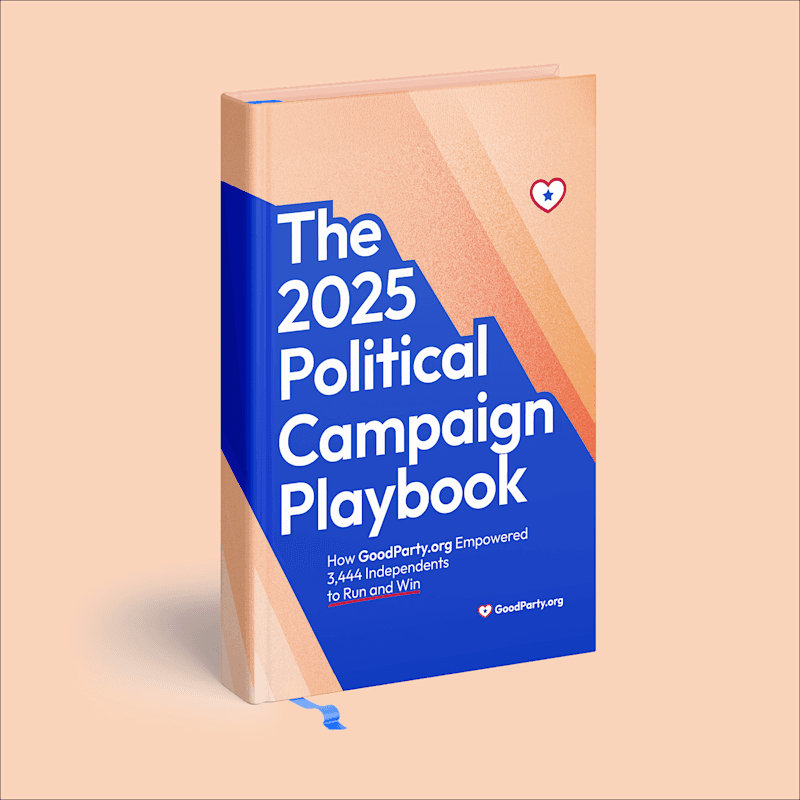
Engaging Voters: The Contact Phase of a Political Campaign
In the middle of a political campaign, nothing is more important than making genuine connections with voters.
At GoodParty.org, we like to break the timeline of a political campaign into three distinct stages: the Awareness Phase, Contact Phase, and Vote Phase. In this guide, we’ll explore the ins and outs of the Contact Phase.
Want an overview of all three campaign stages? Read our full guide here.
What Is the Contact Phase of a Political Campaign?
The Contact Phase of a political campaign is when voter outreach becomes more direct and intensive. This phase begins after the candidate has established initial awareness, and continues through the primary election and into the general election campaign. During this phase, the campaign shifts from building recognition to actively engaging voters and mobilizing support. Personal interactions with voters — whether through canvassing, phone banking, or digital outreach — become the core focus.
We can further break down the Contact Phase into three subphases:
Focus on Outreach: The Contact Phase begins after the initial Awareness Phase has established the candidate’s presence in the race. At this point, voters should have some familiarity with the candidate. This phase typically starts in the lead-up to the primary election, when the campaign needs to intensify voter outreach efforts to build a strong base of support.
Primary and General Election Campaigns: The Contact Phase continues through the primary election and into the general election campaign. During the primary, the goal is to advance by mobilizing core supporters. In the general election, the focus shifts to engaging a broader audience, including undecided voters.
Ongoing Voter Engagement: Voter engagement during the Contact Phase is an ongoing effort that requires regular interaction with voters. Whether through canvassing, phone banking, or digital outreach, campaigns must stay in constant communication with voters to ensure they remain engaged and supportive.
Generally, the Contact Phase continues until 4-6 weeks before the general election. At that point, the campaign shifts into its final phase, the Vote Phase. The focus then turns toward converting the support raised in the Contact Phase into actual votes on election day.
A Candidate’s Main Goals During the Contact Phase
During the Contact Phase of a political campaign, the main goal is to rally support among potential voters.
Here are some more specific goals to check off during this stage:
Establish a strong campaign team. As your campaign shifts its focus toward voter outreach, assemble an enthusiastic team of volunteers and campaign staff members. Volunteers will be essential to powering your campaign activities.
Train and empower volunteers. In addition to recruiting volunteers, providing the proper training and encouragement for volunteers is crucial. Ensure that volunteers have the tools they need to make positive contributions to your campaign.
Engage voters through door-to-door canvassing. Organize campaign volunteers to go door to door and make one-on-one connections with voters. Prepare door hangers or other promotional materials that volunteers can leave with voters after their visit.
Invest in phone banking. Phone banking allows campaigns to reach a large number of voters in a short amount of time. Volunteers can make calls to encourage voter registration, promote the candidate’s platform, and remind voters to turn out on election day.
Take advantage of SMS/MMS messaging. Like phone banking, SMS/MMS text messaging lets campaigns reach a large number of voters in little time. It is also a great way to personalize voter outreach.
Spread your message through digital outreach. Email marketing, online advertising, and building your social media presence are all powerful ways to use digital outreach to your campaign’s advantage.
Continue to refine the campaign’s message. As your campaign engages with voters, it gathers valuable feedback that can be used to refine campaign messaging. Voters’ responses to the candidate’s platform, priorities, and positions can help the campaign adjust its outreach efforts to better resonate with the electorate.
Throughout the Contact Phase of a political campaign, it is imperative to keep voters at the heart of your campaign’s goals and priorities.
How to Reach More Voters During the Contact Phase
The level of success your campaign earns in the Contact Phase depends partly on the tools and technology you use to reach voters. The tools you choose affect how far your campaign budget can stretch and how easily volunteers can support your campaign.
That’s why GoodParty.org has pioneered free and low-cost campaign tools, perfect for grassroots campaigns up and down the ballot.
Here are just some of the ways GoodParty.org’s campaign tools can take your campaign activities farther during the Contact Phase:
Voter File Access: Use GoodParty.org’s affordable voter data to segment your audience and target outreach efforts more effectively. Personalize your message based on voters’ demographics, political leanings, and more. Voter data can shape your strategy in door-to-door canvassing, phone banking, text campaigns, direct mail, and digital advertising.
Campaign Activity Tracker: Use GoodParty.org’s easy-to-use activity tracker to chart your progress toward voter outreach goals. Track the number of doors knocked, calls made, and online impressions created. Easily calculate how many voters you still need to reach during the Contact Phase.
Integration with Ecanvasser: Ecanvasser is an essential tool for managing voter interactions during the Contact Phase. Use Ecanvasser to organize and manage canvassing teams, track which areas have been canvassed and which still need attention, and record voter interactions in real time.
SMS/MMS Messaging: GoodParty.org offers candidates access to SMS/MMS messaging support for a low wholesale price, so you can send text messages to more voters and keep your campaign front-of-mind for more community members.
In addition to these benefits, signing up for GoodParty.org gives you access to free AI campaign content generators, so you can continue refining and updating your campaign messaging. Candidates also receive access to GoodParty.org’s volunteer community, plus free campaign training sessions to help you level up your voter outreach strategy.
Get Started with GoodParty.org’s Campaign Tools
The Contact Phase is one of the most important stages of a political campaign. It’s when the campaign shifts from building recognition to actively engaging and mobilizing voters. By focusing on direct voter engagement, volunteer mobilization, and refining your campaign’s messaging, you can build a committed voter base that will carry your campaign through to election day.
GoodParty.org’s campaign tools and voter file access are invaluable resources during this phase. Whether you’re segmenting voters for targeted outreach or managing canvassing efforts, these tools can help you streamline your campaign and maximize voter engagement.
Make a free account to get started today, or book a meeting with our team to talk about your options and campaign strategy.
Want to keep learning about the phases of a successful political campaign? Read our guides on the first and last phases of an effective campaign here:

